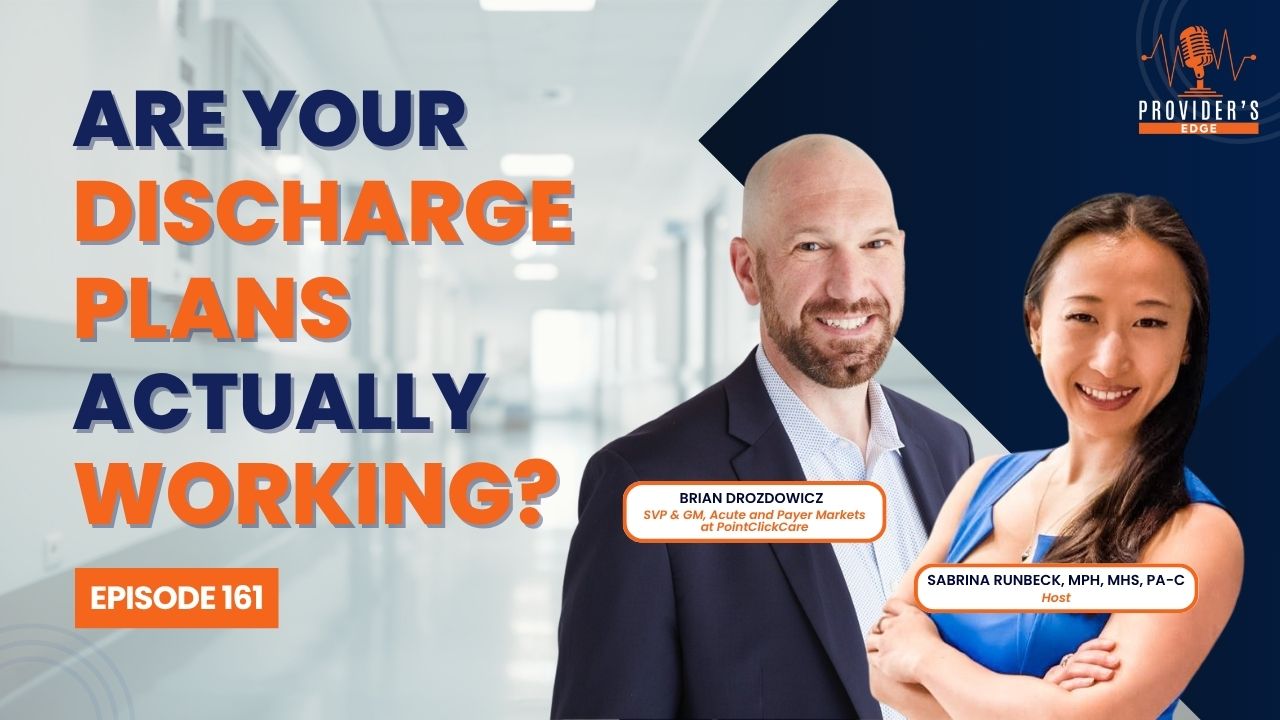
AI, Interoperability & Outcomes:
The Next Investment Edge in HealthTech
Every year, over $30 billion is wasted in poorly managed care transitions. But what if the issue isn’t a lack of data—but a lack of usable, timely, and actionable insight?
For investors, this isn’t just a clinical failure. It’s an opportunity.
In this piece, we unpack how tech-enabled discharge planning, real-time data integration, and post-acute care alignment are converging to create the next major edge in healthtech investing. And why PointClickCare’s ecosystem model may be setting the new standard.
Listen anywhere you get your podcastin' on.
Live Interview

Why AI Alone Isn’t Enough Without Interoperability
There’s no shortage of AI hype in healthcare. But most AI tools today are still isolated—an add-on, not an integrator.
The companies that will lead the next wave of outcomes-based ROI aren’t just building algorithms. They’re embedding intelligence directly into the workflow, surfacing insights where decisions happen.
Brian Drozdowicz, SVP at PointClickCare (PCC), highlights this distinction clearly: “We’re not just pushing data. We’re connecting the right teams across the entire continuum.”
That means:
- Discharge summaries auto-summarized for downstream providers
- Risk flags embedded into EHRs
- Visibility across ACOs, SNFs, hospitals, and payers
Investors betting on standalone solutions miss this critical point: interoperability is the multiplier.
"Too often, I see founders focus on building shiny dashboards without thinking about the systems their tools need to connect into. If your solution isn't interoperable, it's not scalable." — Sabrina Runbeck
The PointClickCare Model: A Case Study in Ecosystem Integration
With its PacMan tool and acute-to-post-acute visibility stack, PCC is becoming a central nervous system for transitional care.
Instead of building a niche app, PCC has:
- Integrated with major EHR systems
- Partnered with hospital systems and skilled nursing facilities
- Provided real-time patient movement tracking
- Piloted AI-driven discharge simplification
The result? Time savings, better outcomes, and reduced hospital readmissions.
Sabrina Runbeck, host of Provider’s Edge and a growth strategist for healthtech scaleups, noted: “If we’re just saying, 'I have an order,' but don’t attach a care plan, then we don’t have a roadmap."
PCC’s model solves for that by creating a true roadmap—with stakeholders aligned at every step.
And their AI layer doesn’t aim to replace clinicians. It reduces noise. It curates context. It allows staff to prioritize what matters most.
"Technology should enable the care team, not exhaust them. When a founder tells me their AI product saves time, my next question is: for whom, and how does it show up in their day-to-day?" — Sabrina Runbeck
What Most Investors Miss About Post-Acute Innovation
There’s been a lot of focus on digital front doors and acute hospital systems. But post-acute care—especially SNFs and home health—remains one of the biggest cost and outcome variables.
This sector is where some of the most critical patient decisions get made: medication reconciliation, follow-up planning, therapy adherence. And yet, it's been chronically underdigitized.
What makes it ripe for investment?
- Under-digitized workflows
- High fragmentation
- Direct link to readmission penalties
- Increasing pressure for VBC participation
Brian noted during his interview: “AI has the opportunity to fully change how clinicians interact with software—making their lives far more efficient.”
The leverage isn’t just clinical. It’s operational.
And PCC is showing it can be done without overhauling everything—just by making existing tools usable.
There is also a behavioral component. As Sabrina noted, "Founders who ignore the human habits in healthcare—the way clinicians actually use systems—will struggle with adoption, no matter how smart their tech is."
The Metrics That Matter: Scaling with Clarity
When assessing companies in this space, smart investors are looking beyond user growth or app downloads.
Here’s what really signals success:
- Clinical adoption rates: Are frontline teams actually using it?
- Integration partnerships: Is it embedded in major EHRs or care pathways?
- Readmission reduction data: Are outcomes measurable and repeatable?
- VBC alignment: Does the solution improve performance under value-based contracts?
- Workflow fit: Can it be adopted without adding friction?
PCC hits these across the board. It’s not flashy tech—it’s sticky, scalable infrastructure.
More importantly, it creates value for every stakeholder in the ecosystem:
- Patients get better follow-through.
- Providers reduce time spent on documentation.
- Payers see reduced costs and improved quality metrics.
- Systems avoid penalties and improve care continuity.
"It's easy to measure features. But real value shows up in adoption, adherence, and aligned incentives. That's what investors should track." — Sabrina Runbeck
Investor Takeaways: Where the Edge Lies
Founders chasing clinical outcomes are often dismissed for being "too complex" or "too early stage."
But here’s the truth: the complexity IS the moat.
Back-end interoperability, embedded AI, and discharge-to-home alignment may not make headlines—but they’re driving outcomes that payers, health systems, and buyers are demanding now.
This is where the next fundable edge lies.
If you’re an investor looking to place smart bets in healthtech, watch for:
- Tools that simplify care transitions
- Companies embedding into care delivery, not sitting on the sidelines
- Teams solving messy coordination, not just shiny dashboards
Sabrina summarizes it best: "We're entering a phase where buyers are no longer seduced by innovation alone. They're buying integration, alignment, and results. That's the investor's edge."
Ready to Meet the Founders Solving This?
Every month, Provider’s Edge features Series A+ founders solving healthcare’s hidden challenges.
From discharge coordination to data simplification, these are the companies building what health systems are asking for—and investors are starting to notice.
Apply to meet them, or nominate your portfolio company to pitch at:
HealthTechShowdown.com
Or test how investment-ready your own startup is with our free:
ImpactQuotientQuiz.com
Recommended Podcast Episodes
Be a guest on our show
The Provider's Edge show is always looking to feature healthcare change-makers and celebrate the work they are doing to improve healthcare.
Together, we can encourage other healthcare entrepreneurs and startup founders to up-level their businesses.
If you or someone you know could be a good fit as a guest on the show, please click on the bottom below to apply as a speaker.
Healthcare Entrepreneurs!
I can help you gain visibility and credibility in the right circles so you can accelerate your mission and profitability!
After overcoming burnout working in surgery, I went back to my roots in neuroscience and public health. I learned the importance of building key human relationships with my team throughout our organization.
While helping healthcare executives and entrepreneurs to get out of the day-to-day operation of their practice, I realized I needed more visibility and more connections to reach my ideal clients.
Once I set out to be highly visible in the right circles, I was able to leverage my network of strategic partners to convert clients 5x higher than any other marketing channel I had tried previously.
Now I help healthcare change-makers to accelerate their impact and increase profitability by gaining visibility and credibility with the right strategic partners.
My clients no longer worry about where their next client is coming from, the need to plan additional budget for ads spending, or losing the ability to connect with others because their social media account is shut down.
If you want to share your social mission with the world and gain pivotal supporters that become loyal clients... then you are in the right place, with the right consultant who is also a recovered clinician.




